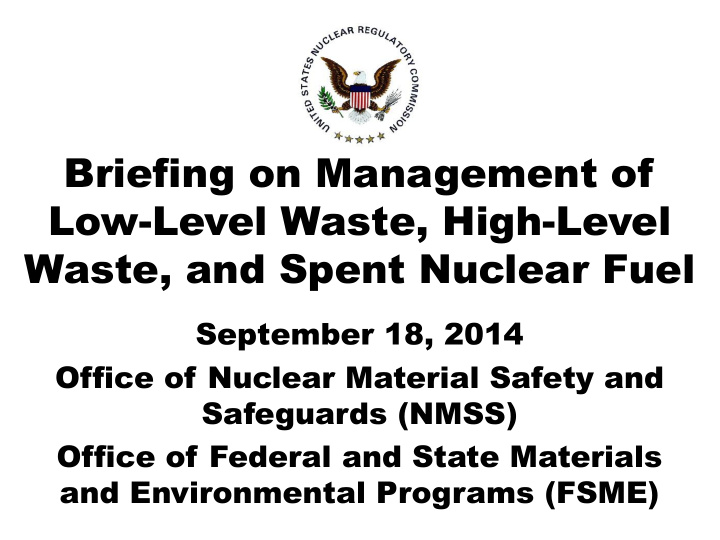



Briefing on Management of Low-Level Waste, High-Level Waste, and Spent Nuclear Fuel September 18, 2014 Office of Nuclear Material Safety and Safeguards (NMSS) Office of Federal and State Materials and Environmental Programs (FSME)
Agenda • Introduction • Overview • Low-Level Waste Management and Disposal • Spent Fuel and High-Level Waste Management • Questions 2
Nuc Nuclear lear Waste aste and and Spen Spent t Fuel Man Fuel Managem gement ent Ov Over erview view Catherine Haney, Director Office of Nuclear Material Safety and Safeguards (NMSS) 3
NRC is integrating its activities across the nuclear fuel cycle • Consideration of different fuel types • Management of spent fuel in wet and dry storage 4
Staff is mindful of the strategy for high level waste and spent fuel • Possible changes that may affect NRC’s Regulatory Framework • Awareness of international programs for all waste types • Agency role in implementing National Policy 5
NRC has a successful regulatory framework for current and future spent fuel inventories 6
NRC has a successful regulatory infrastructure for Low-Level Waste • Used by Agreement States to ensure protection of public health and safety 7
Lo Low-Le Level el Waste aste Mana Managem gement ent and and Disposa Disposal Larry Camper, Director Division of Waste Management and Environmental Protection, FSME 8
Topics • Legislative and regulatory structure for commercial Low- Level Waste (LLW) disposal • Current activities in NRC LLW Program • Staff communication with the Commission 9
Comprehensive legislative and regulatory structure exists Statutory History • NRC Regulatory • Oversight 10 CFR Part 20 • 10 CFR Part 51 • 10 CFR Part 61 • 10 Regional Compacts 10
Disposal facilities exist in the U.S. and internationally • Role of the Compact System • 4 Agreement States Disposal Facilities • 4 Inactive/Closed Disposal Facilities • International Experience and Interface 11
Sufficient Disposal Capacity Now Figure 1: Volume of Waste Disposal for Utility Generator (Source: MIMS, December 2011) 3,000,000 LLW Volume Per Year (ft3) 2,500,000 2,000,000 1,500,000 1,000,000 500,000 0 12
Projected Growth in Disposal Figure 2: Disposable LLW/Year by Waste Class (Source: EPRI, December 2006) 13
Comparison of Waste Management Systems International Atomic Energy Agency Waste U.S. Waste Categories Categories High Level Waste High Level Waste Intermediate Level Greater-than-Class C LLW Waste Low Level Waste (LLW) Class A, Class B and C LLW Very Low Level Waste Class A Material held for decay Very Short Lived Waste storage Liquids/Air: Effluent releases Exempt Waste Solids: Case-by-case analysis 14
Key actions enhance program effectiveness • Proposed 10 CFR Part 61 Rulemaking • Authorization for Disposal per 10 CFR 20.2002 • Management of LLW for Disposal • Concentration Averaging and Encapsulation Branch Technical Position 15
Continuous improvement through Programmatic Assessment • LLW regulatory program assessment in 2007 • Update LLW Programmatic Assessment • Revisions focused on national circumstances • Extensive stakeholders engagement 16
Greater-than-Class C (GTCC) Waste • Responsibilities outlined in LLRWPAA • NRC authority for licensing GTCC waste disposal facility • Engaging DOE to clarify responsibility • Specification of technical requirements • 10 CFR 61 on GTCC disposal 17
Current and Future Communication with the Commission • Proposed 10 CFR Part 61 • Waste Classification Scheme Revision • Programmatic Assessment Findings • GTCC waste • Joint Convention National Report • Concentration Averaging and Encapsulation Branch Technical Position 18
Spent Fu Spent Fuel el and and High High-Le Level el Waste aste Mana Managem gement ent Mark Lombard, Director Division of Spent Fuel Storage and Transportation, NMSS 19
Topics • Transport and storage framework • Self-assessment and enhancements • Internal and external communication • Collaboration licensees • Ongoing public public outreach 20
Currently reviewing dry storage renewals • Prairie Island • Calvert Cliffs • VSC-24 21
Updating regulatory framework to support renewals • Self-assessment indicated enhancements for sustainable framework • Lessons learned from reactor license renewals 22
Updating regulatory framework to support renewals (cont’d) • Industry developing guidance • Collaborative efforts with DOE, vendors, licensees and public • Update of NUREG 1927 23
Radioactive material is being transported safely • Type B packages – Medical and other uses – Expired Type B packages phased out
Radioactive material is being transported safely (cont’d) • NUREG 2125, “Spent Fuel Transportation Risk Assessment” Residents near Traffic on the stops, 0.000012 route 0.00046 Truck crew and escorts, 0.00068 Total Shipment Dose: 0.0037 Residents near route, 0.000096 Inspector, 0.0016 Background 7.56 Persons sharing stop, 0.00086 Doses from Background and from a Truck Shipment of Spent Nuclear Fuel (Person-SV) 25
Long-term storage and transportation of a range of fuel cladding types is safe • Approved systems maintain safety and security margins Push-pull force applied to • Many of these involve U-frame results in bending moment on the fuel sample high burnup fuel and shorter cooling times – MP-197 • Research activities confirm NRC position Location of fuel sample 26
Extended storage and transportation program is moving forward • Issued Technical Information Needs Report • Conducting research based on identified needs and priorities 27
Readiness to Review Interim Consolidated Storage Facility Applications • 10 CFR 72 is adequate for storage and packaging operations • Monitoring implementation of DOE’s “Strategy for the Management and Disposa Disposal of l of Used Nuc Used Nuclea lear r and High and High- Level Radioactive Waste” 28
QUESTIONS QUESTIONS 29
Acronyms CFR – Code of Federal Regulations • CoC – Certificate of Compliance • DOE – Department of Energy • EPRI – Electric Power Research Institute • GTCC – Greater-than-Class C • ISFSI – Independent Spent Fuel Storage • Installation Amendments Act of 1980 • LLW - Low Level Waste • MIMS - Manifest Information Management System • VLLW – Very Low Level Waste 30
Recommend
More recommend